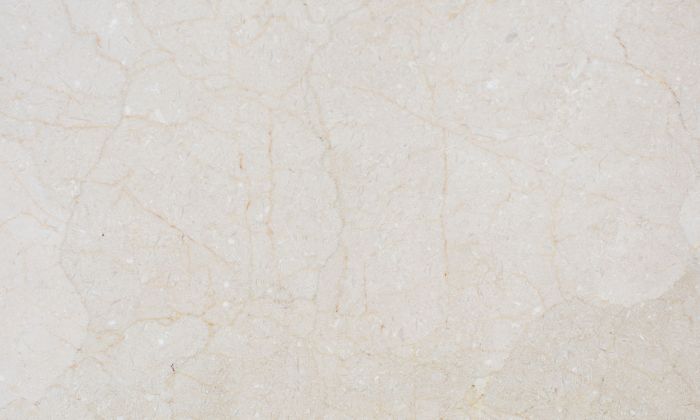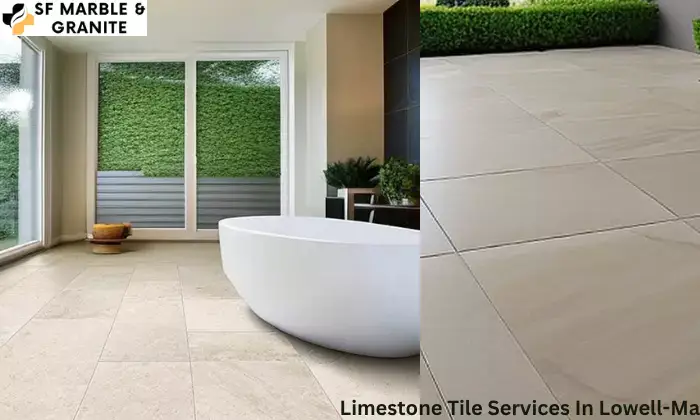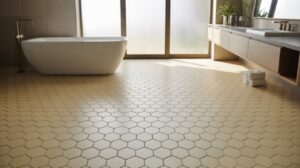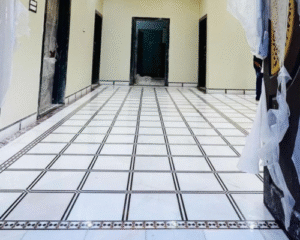Discover the Beauty and Durability of Limestone Tile for Flooring & Walls
Limestone tile is a popular choice for homeowners and designers seeking natural elegance and durability in flooring and wall applications. This stunning stone offers a range of finishes and textures, making it versatile for different spaces.
Its unique aesthetic appeal and strength make it a top contender in both modern and traditional home designs. In this guide, we’ll explore the its characteristics, benefits, and applications, along with comparisons to other natural stones.
Table of Contents
Toggle
What is Limestone Tile?
Limestone tile is made from natural limestone, a sedimentary rock formed over millions of years from compressed marine organisms and minerals. The result is a durable and aesthetically pleasing material available in various colors, including beige, cream, grey, and even blue hues. These tiles are ideal for creating a timeless and sophisticated look in any home or commercial setting.
Types of Limestone Tile
Limestone tiles come in different finishes, each offering unique textures and characteristics. Below are the four main types:
Tumbled Limestone Tile
Tumbled limestone tiles offer a rustic, aged look due to their softened edges and textured surface, achieved through the tumbling process. This natural stone is ideal for creating a vintage or old-world charm in spaces like bathrooms, entryways, and patios.
The rough texture of tumbled limestone not only enhances its aesthetic appeal but also provides excellent slip resistance, making it a practical choice for wet areas. These tiles blend durability with timeless beauty, offering both functionality and style in various settings, whether indoors or outdoors.
Honed Limestone Tile
Honed limestone tiles feature a smooth, matte finish, offering a refined and subtle look. Ideal for indoor spaces like kitchens, bathrooms, and living rooms, these tiles create an elegant yet understated appearance. The matte surface enhances the natural beauty of the limestone while providing a sleek and sophisticated feel.
Because of their finish, honed limestone tiles are perfect for homeowners seeking a timeless, low-gloss aesthetic. Their versatility and natural appeal make them a popular choice for various design styles, adding warmth and texture to interior spaces without overwhelming the décor.
Brushed Limestone Tile
Brushed limestone tile features a textured surface achieved by brushing the stone with metal brushes, creating a unique, slightly weathered look. This finish highlights the stone’s natural patterns, adding depth and character. Brushed limestone is ideal for spaces needing a blend of rustic charm and modern elegance.
It’s commonly used in areas like garden paths, hallways, and dining rooms, where its subtle texture provides both aesthetic appeal and slip resistance. The timeless look of brushed limestone complements various design styles, making it a versatile choice for both indoor and outdoor applications.
Polished Limestone Tile
Polished limestone tiles feature a high-gloss finish that enhances the stone’s natural beauty and colors, adding a luxurious touch to interiors. This reflective surface makes it ideal for elegant spaces like foyers, bathrooms, and accent walls.
While it creates a sophisticated look, the polished finish can become slippery when wet, making it better suited for low-traffic areas or areas treated with non-slip solutions. Its smooth surface highlights the stone’s patterns, adding depth and style to any room where a high-end aesthetic is desired.
Benefits of Limestone Tile
Limestone has several advantages that make it a preferred choice for many homeowners.
Aesthetic Appeal
Aesthetic appeal lies in the natural beauty of these tiles, which feature unique veining and color variations that make each piece distinct. Their classic, timeless charm can elevate the look of any interior or exterior design. Whether used in kitchens, bathrooms, or outdoor spaces, these tiles create an elegant and inviting atmosphere.
The warm tones and organic patterns add depth and character, blending well with various design styles. Their versatility and visual appeal make them a popular choice for homeowners seeking both luxury and a natural aesthetic in their spaces.
Durability
Limestone is a highly durable natural stone, ideal for areas with heavy foot traffic such as kitchens and living rooms. Its strength ensures longevity, and with proper maintenance, limestone tiles can retain their beauty and appeal for decades. This durability makes limestone a practical choice for both residential and commercial spaces.
Regular sealing and cleaning protect it from wear and tear, ensuring it stays in good condition. Overall, limestone combines resilience with aesthetic appeal, offering a lasting solution for flooring and other surfaces in your home or business.
Versatility
Limestone’s versatility makes it an ideal material for various applications. It can be used for indoor spaces like flooring, countertops, backsplashes, and wall cladding, adding warmth and elegance. Additionally, its durability makes it suitable for outdoor areas such as patios and pool surrounds.
Limestone’s natural beauty and adaptability allow it to complement both cozy interiors and stylish outdoor retreats. Whether you’re looking to enhance your home’s indoor ambiance or create a stunning outdoor space, limestone offers a flexible, aesthetic solution that fits perfectly with a wide range of design styles.
Environmental Friendliness
Limestone is an environmentally friendly material due to its natural origins, contrasting with synthetic options such as ceramic or porcelain tiles. Being a natural stone, it has a low carbon footprint during production. Its durability ensures a long lifespan, minimizing the frequency of replacements needed.
This longevity not only reduces waste but also conserves resources, making limestone a sustainable choice for various applications. By opting for limestone, consumers contribute to eco-friendly practices while enjoying the aesthetic and functional benefits of a natural product. Overall, limestone stands out as a responsible choice for environmentally conscious construction and design.
Limestone Tile Applications
Limestone tiles offer a range of applications in both residential and commercial settings.
Flooring
Limestone floor tiles are a fantastic option for kitchens, bathrooms, and living rooms due to their natural beauty and durability. They effectively blend functionality with aesthetic appeal, making them suitable for various spaces. The textured finishes available in some limestone tiles enhance slip resistance, which is particularly beneficial in wet areas, ensuring safety without compromising style.
Their timeless look adds elegance to any interior design while standing up to daily wear and tear, making limestone an ideal choice for both high-traffic areas and serene spaces. Overall, limestone tiles combine practicality and charm effortlessly.
Wall Cladding
Limestone tiles are an excellent choice for wall cladding, enhancing the aesthetic appeal of both interior and exterior spaces. Their natural texture and warm tones add depth and character, making them ideal for creating feature walls in living rooms or stylish facades for buildings.
The versatility of limestone allows it to complement various design styles, from rustic to contemporary, while its durability ensures longevity. Whether used in residential or commercial settings, limestone wall cladding provides a refined and timeless look that elevates the overall ambiance of any space.
Outdoor Areas
Limestone is a favored choice for outdoor areas, including patios, garden pathways, and pool surrounds. Its natural texture enhances aesthetic appeal while ensuring slip resistance. This stone is renowned for its durability, making it resilient against weathering and wear, which is essential for outdoor applications.
Additionally, limestone’s ability to withstand environmental elements contributes to its longevity, providing a reliable and attractive solution for enhancing outdoor spaces. Whether used for functional surfaces or decorative accents, limestone combines beauty and practicality, making it an ideal material for various outdoor projects.
Backsplashes and Countertops
Limestone is a versatile material that can beautifully enhance kitchens and bathrooms as backsplashes and countertops. Its unique patterns and soft color tones add visual interest and depth, making it an attractive choice for interior design. The natural variations in limestone create a cohesive and elegant look, complementing various styles from rustic to modern.
Additionally, its durability and ease of maintenance make it practical for high-use areas. Incorporating limestone into these spaces not only elevates aesthetics but also adds a touch of luxury, transforming ordinary kitchens and bathrooms into stunning focal points.
Limestone Tile Installation: Step-by-Step Guide
Proper installation is key to ensuring the longevity and beauty of limestone tile.
Preparation
Preparation is a crucial step before tile installation. Ensure the surface is clean, dry, and level to guarantee proper adhesion and a smooth finish. Any debris or moisture can interfere with the bonding process, leading to potential issues later.
Gather all necessary materials beforehand, including mortar for adhesion, tiles to be installed, spacers for uniform gaps, grout to fill the spaces between tiles, and sealer to protect the finished surface. Taking the time to prepare adequately will help ensure a successful and durable installation that enhances the aesthetic of the space.
Laying the Tile
- Apply a layer of mortar on the surface.
- Place the limestone tiles carefully, using spacers to maintain even gaps.
- Allow the tiles to set for the recommended time.
Grouting and Sealing
Grouting and sealing are essential steps in tile installation. After laying the tiles, grout is applied to fill the gaps between them, ensuring a finished look. Sealing is critical for limestone tiles, as it protects against stains and moisture damage. This process helps maintain the tile’s appearance and durability over time.
To preserve the beauty and longevity of limestone, it is advisable to reseal the tiles periodically. Regular maintenance of both grout and sealant not only enhances the visual appeal but also extends the lifespan of the tiled surface, making it a worthwhile investment.
Limestone Tile Maintenance and Care
Limestone require proper maintenance to retain their beauty.
Cleaning Routine
To maintain the integrity of your tiles, establish a regular cleaning routine using a pH-neutral cleaner, which prevents potential damage from harsh chemicals. For routine cleaning, simply wipe the tiles with a damp cloth or mop. For deeper cleaning, employ a soft brush or mop to gently scrub the surface, removing stubborn dirt and stains without scratching or harming the tile finish.
Always ensure to rinse the tiles thoroughly with clean water after cleaning to eliminate any residue from the cleaner, promoting a sparkling, well-maintained appearance while preserving the tile’s longevity.
Sealing Limestone Tile
Sealing limestone tile is crucial for maintaining its appearance and longevity. This protective layer helps prevent stains and moisture absorption, which can lead to damage over time. Regular sealing enhances the tile’s natural beauty and durability. It’s advisable to reseal limestone tiles every 1-2 years, although this may vary based on the tile’s usage and the environment.
High-traffic areas or spaces exposed to spills may require more frequent sealing. By following a proper sealing routine, you can ensure that your limestone tiles remain in excellent condition, reducing the risk of permanent stains and damage.
Dealing with Stains
To effectively handle stains on stone surfaces, it’s important to act quickly. Use a mixture of baking soda and water to create a gentle paste, applying it directly to the stained area. Allow the paste to sit for a few minutes before gently scrubbing with a soft cloth or sponge.
This method is safe and effective for most types of stone. Avoid using harsh chemicals or abrasive cleaners, as these can cause damage and dull the surface. Regular maintenance and prompt cleaning of spills will help keep your stone surfaces looking pristine and free from stains.
Limestone Tile vs. Other Natural Stones
Limestone vs. Marble
Limestone and marble are both popular natural stones, but they have distinct characteristics. Limestone is generally more affordable and requires less maintenance, making it a practical choice for various applications. It has a softer, rustic appearance, suitable for casual settings.
In contrast, marble is known for its luxurious, polished finish, making it a favored option for upscale designs and elegant spaces. While marble can enhance aesthetics, it often demands more care to prevent staining and scratching. Ultimately, the choice between limestone and marble depends on budget, maintenance preferences, and desired style.
Limestone vs. Travertine
Limestone and travertine are both durable natural stones, but they have distinct characteristics. Travertine features a more textured surface with natural holes, giving it a unique appearance, while limestone has a smoother finish. Although both stones are resilient, travertine’s higher porosity makes it less suitable for high-moisture environments, as it can absorb water and stains more easily.
Consequently, limestone is often preferred in areas prone to moisture, such as bathrooms or kitchens, due to its lower porosity and smoother surface, which helps maintain cleanliness and durability over time.
Limestone vs Slate
Limestone and slate differ significantly in appearance and texture. Slate typically features darker hues and a rugged, uneven surface, making it suitable for rustic environments. Its durability and natural cleft texture add to its charm. In contrast, limestone presents a broader color palette, often featuring lighter shades, and boasts a smoother texture, lending itself to more elegant and sophisticated settings.
While limestone is favored for polished, refined spaces, slate is ideal for casual, earthy aesthetics. Each material offers unique benefits, making them suitable for different design preferences and architectural styles.
Cost of Limestone Tile
Several factors influence the cost of limestone tile, including the type, size, finish, and quality. On average, tile costs range from $4 to $10 per square foot. This price is comparable to other natural stones like travertine but more affordable than marble. Limestone is also more cost-effective than porcelain or ceramic tiles when considering its long-term durability.
Conclusion
Limestone tile is a beautiful and durable choice for both flooring and walls. Its natural charm, versatility, and eco-friendly benefits make it a popular option for homeowners and designers alike. Whether used for flooring, wall cladding, or outdoor spaces, limestone enhances any environment with timeless appeal and durability.








